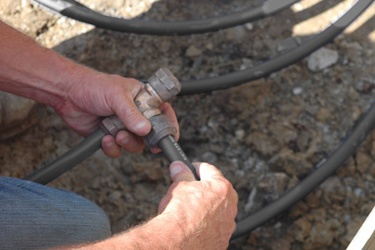HDPE Only Pipe Material For Water Service Lines Using AWWA Standard

In collaboration with more than 30 committee and subcommittee members, the American Water Works Association (AWWA) has updated its C901 Standard for PE4710 high-density polyethylene (HDPE) pressure pipe for use in potable water, reclaimed water and wastewater service lines. ANSI/AWWA C901-25 Polyethylene (PE) Pressure Pipe, Tubing and Fittings, ¾ In. (19 mm) Through 3 In. (76 mm), for Water Service is now available from the AWWA website. The first edition of C901 was approved by the AWWA Standards Council on January 28, 1978, and this eighth edition was published on July 1, 2025.
Major changes to C901 include the addition of detailed requirements for fittings, including materials, workmanship, dimensions, tolerances, physical requirements, testing, and marking. In addition, the new standard contains a descriptive statement about use of lead-free HDPE pipes and fittings and Lead Service Line (LSL) replacement: “HDPE pipes and fittings …are considered lead-free per US Safe Drinking Water Act when certified to NSF/ANSI/ CAN 61, NSF/ANSI/CAN 372, or NSF/ANSI 14 [pw end use (for potable water)]. Existing LSL can be replaced with HDPE using open cut and a variety of trenchless installation methods. Refer to ANSI/AWWA C810 for additional information.”
Also, ANSI/AWWA C901-25 includes a new Appendix titled EPA Regulated PFAS Chemicals and HDPE. Based on a survey by the Plastics Pipe Institute, Inc., it was concluded that ‘the chemicals identified in EPA’s PFAS National Primary Drinking Water Regulation Rulemaking issued on April 10, 2024, are not intentionally added in the finished HDPE piping materials.” Also, research published in the Journal of the Australian Water Association concluded “that permeation of undamaged PE … pipe by PFAS is unlikely…”
The ANSI/AWWA C901-25 Standard describes dimension ratio (SDR) for pipe and tubing made with material code designation PE4710 with a pressure class of 250 psi for water at 80°F and lower temperatures. For higher temperatures up to 140°F, references can be found in the AWWA M55 manual. Pipe ranging in nominal size from ¾ through 3 inches that conforms to the outside-diameter (OD) dimensions of iron pipe size (IPS). Tubing ranging in size from ¾ through 2 inches conforms to the OD dimensions of copper tube size (CTS).
“This continues to be a key document when planning and installing a water service piping system, and especially for using HDPE for lead service line replacement,” stated Camille George Rubeiz, P.E., F. ASCE, who served as the chair on the AWWA C901 Subcommittee responsible for updating the standard. “It emphasizes the fact that HDPE pipe can be used in lead service line replacement projects in open cut trenching and by using any of a number of trenchless installation methods. This makes HDPE the only material that can be designed and installed for service (C901 for 3/4 to 3 inches), distribution and transmission (C906 for 4 to 65 inches) piping systems using ANSI/AWWA standards and the AWWA M55 Manual.”
This C901-25 subcommittee included Gerry Groen, Infra Pipe Solutions, Mississauga, Ontario; Casey Haynes, H2E, and formerly with City Utilities, Springfield, MO; Amster Howard, formerly with the US Bureau of Reclamation, Lakewood, CO; Camille Rubeiz, Plastics Pipe Institute; Andrew Schipper, Fort Wayne City Utilities, Ft Wayne, IN; Jeff Wright, Georg Fischer Central Plastics LLC, Shawnee, OK.
Rubeiz said that there is also related information in the AWWA M55 manual titled PE Pipe- Design and Installation. “This is a comprehensive AWWA manual about HDPE pipes and joining systems, detailing fittings, fusion and electrofusion. There are also sections on hydraulics, pressure ratings, external loads, standards, hydrotesting and commissioning, maintenance and repairs, model specifications, plus earthquake applications. Additionally, there are case studies, and installation techniques such as open cut (basic and engineered), marine, and trenchless methods such as Horizontal Directional Drilling, Pipe Bursting and Sliplining/Compression Fit.”
Additional details about both the new AWWA C901-25 Standard and the M55 Manual can be found at the AWWA and PPI websites and by scanning:

For more information, visit www.plasticpipe.org/mabpubs

PPI is the major trade association representing the plastic pipe industry. For more information, visit www: plasticpipe.org.
About PPI:
The Plastics Pipe Institute, Inc. (PPI) is the major North American trade association representing the plastic pipe industry and is dedicated to promoting plastic as the materials of choice for pipe and conduit applications. PPI is the premier technical, engineering and industry knowledge resource publishing data for use in the development and design of plastic pipe and conduit systems. Additionally, PPI collaborates with industry organizations that set standards for manufacturing practices and installation methods.
Source: The Plastics Pipe Institute, Inc. (PPI)
